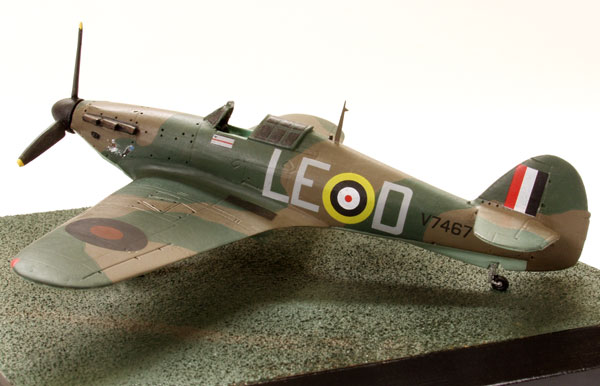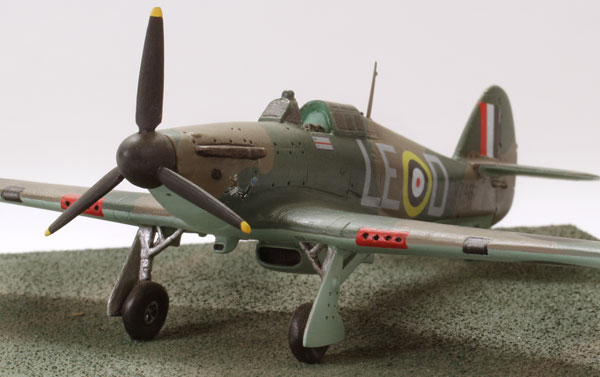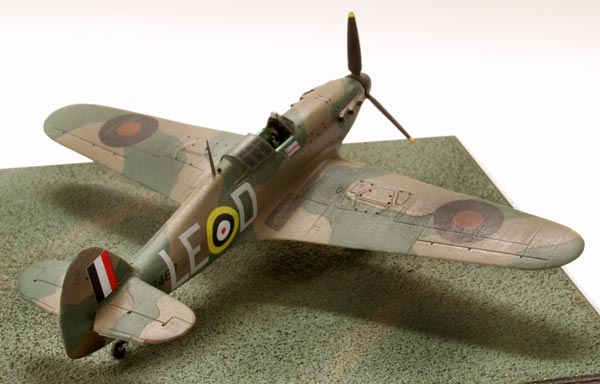Hawker Hurricane Mk I
Hawker Hurricane Mk I V7467 LE-D
242 Squadron (Canadian), Sqn Ldr Douglas Bader, Coltishall, 1940.
Probably the most widely-known participant in the Battle of Britain, Bader was born in St John’s Wood, London on February 21st 1910.
His early years were spent in India, where his father was in the Civil Service. Bader returned to England to go to preparatory School at Temple Grove. Eastbourne. He later won a scholarship to St Edward’s College, Oxford. In 1928 he won a prize cadetship to RAF College, Cranwell and began the course there in September.
After passing out in July 1930, Bader was commissioned and on August the 25th he was posted to 23 Squadron at Kenley. In 1931 he represented 23 Squadron in the pairs acrobatic competition at the Hendon Air Display, when the squadron won for the third year running. On December the 14th 1931 Bader crashed in a Bulldog, after attempting a roll at very low level. Miraculously he was not killed but lost both his legs, the right one above the knee and the left below.
After being fitted with artificial limbs, Bader remained in the RAF but most unhappily because he was not allowed to fly. He was retired by the Air Ministry on April 30th 1933. He got a job with the Asiatic Petroleum Company, which later became Shell.
Following the outbreak of war. Bader became increasingly insistent about rejoining the RAF in a flying capacity. Finally, on October the 18th 1939, he went to CFS. Upavon for a flying test, which was conducted by Squadron Leader RHA Leigh (qv). Bader passed the test and was re-employed as a regular officer on November 26th. After a refresher course at Upavon. he joined 19 Squadron at Duxford on February the 7th 1940, with the rank of Flying Officer. In March lie was promoted to Flight Lieutenant and posted to 222 Squadron, also at Duxford, as a Flight Commander.
On June the 1st Bader scored his first victory, when he shot down a Bf 109 near Dunkirk and shared in the probable destruction of a He111. In early July Bader was promoted to Acting Squadron Leader and given command of 242 Squadron at Coltishall, a unit made up mainly of Canadian pilots. Morale was low and discipline was lax when Bader set himself the task of bringing 242 back to a good operational standard and this is when he flew this famous Hurricane.
On July the 11th 1940 Bader shot down a Do 17 into the sea off Cromer. He sent another Do 17 into the sea near Yarmouth on August 21th and claimed two Bf 110s destroyed on the 30th. Bader claimed two Bf 110s destroyed on September 7th, a Do 17 shot down and two others damaged on the 9th, another Do 17 destroyed and two more damaged on the 15th, a Ju 88 and a Do 17 destroyed on the 18th and a Bf 109 shot down and probably a second on the 27th. Bader’s final victory with 242 was a shared Ju 88 on January the 22nd 1941, shot down into the North Sea, east of Yarmouth.
Bader was promoted to Acting Wing Commander and posted to Tangmere as Wing Commander Flying on March 18th 1941. In June he began to add to his victories in sweeps over France, on June the 21st a Bf 109, on the 26th a Bf 109 and another shared and on July 2nd another Bf 109 and a second one damaged.
On the 4th Bader probably destroyed a Bf 109, on the 6th he shot one down, on the 9th probably destroyed one and damaged a second, on the 1Oth destroyed one and probably a second, on the 12th destroyed one and damaged three others, on the 19th destroyed one, probably a second and shared in the destruction of a third.
Bader shared another Bf 109 and damaged a second on the 21 st and damaged another on the 23rd. He led the Wing on August 9th to escort
bombers to Bethune. From the start things went wrong and he found himself alone and involved with several Bf 109s. In the ensuing combat, south of Le Touquet, he claimed a Bf 109 destroyed and probably a second before he was himself shot down. Bader baled out and was captured on landing, minus his right artificial leg. For the Germans he was a difficult prisoner and he eventually finished up in Colditz Castle. He was released from there on April 14th 1945.
Alter rest and recuperation. Bader was posted to Tangmere, as a Group Captain, to command the Fighter Leaders’ School. Many things had changed since 1941 and it was not a successful appointment. After a short period, Bader was given command of the North Weald Sector, from where he organised and led the Battle of Britain flypast in September 1945.
Bader retired on July 21st 1946, retaining the rank of Group Captain. He had received the following orders and decorations, DSO (1.10.40). Bar to the DSO (15.7.41). DFC (7.1.41). Bar to the DFC (9.9.41), Legion d’Honneur, Croix de Guerre and three Mentions in Dispatches.
After retiring Bader rejoined Shell. In 1952 he was made Managing Director of the Shell aircraft fleet, an appointment which necessitated a lot of overseas travel. Somehow, he always found time to encourage disabled people, particularly children and young people. For his public service. Bader was made a CBE in 1956.
He became Sir Douglas when he was created a KBE in 1976. He flew his own aeroplane for the last time on June 4th 1979, wlien he made a local flight from White Waltham.
On September the 5th 1982, after attending a dinner in honour of Marshal of the RAF Sir Arthur Harris. Bader died in the car as his wife drove him back to their Berkshire home.
PO 26.7.30 FO 26.1.32 Retired 30.4.33 FO 26.11.39 FL 12.3.40 SL 18..6.41 WC 1. 7.45
Ref: Men of the Battle of Britain by Kenneth G. Wynn (CCB Publications)
Scale 1:72 Wingspan 6.66″ (169 mm)
Base size 6.37″ (162 mm) square (No. 4)
Weight not including base 9 ozs (259 grams)
Total number of models produced 145




